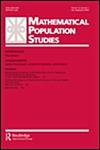使用随机反应技术估计西里西亚省(波兰)高中生的非法药物使用情况
IF 1.3
3区 社会学
Q3 DEMOGRAPHY
引用次数: 0
摘要
摘要:本文采用强迫反应设计的随机反应技术或Liu-Chow方法对波兰西里西亚省高中生中非法药物使用的流行程度进行了估计。被调查者只以一定的概率回答一个敏感问题,从而保证了匿名性。这些方法提供了对患病率的正确估计,而不像基于匿名问卷的访谈,这可能导致低估患病率。与匿名问卷调查相比,强迫回答法高中生使用新型精神活性物质的比例为10.7倍,使用安非他命、冰毒等的比例为6.0倍,使用海洛因或吗啡的比例为3.1倍,使用大麻或大麻的比例为1.6倍。Liu-Chow方法估计使用新型精神活性物质的受访者比例为10.7%,而匿名问卷的估计比例仅为1.5%。在大麻或大麻的情况下,Liu-Chow法给出的估计值为37.0%,而匿名问卷的估计值仅为22.0%。本文章由计算机程序翻译,如有差异,请以英文原文为准。
Estimation of illicit drug use among high school students in the Silesian voivodship (Poland) with the use of the randomized response technique
ABSTRACT The prevalence of illicit drug use among high school students living in the Silesian voivodship (Poland) is estimated using either the random response techniques of forced response design or the Liu-Chow method. Respondents answer a sensitive question only with a certain probability, thus ensuring anonymity. These methods provide correct estimates of prevalence, unlike interviews based on anonymous questionnaires, which can lead to underestimate the prevalence. Compared with those obtained with anonymous questionnaires, the results obtained with the forced response method are that 10.7 times more high school students used the new psychoactive substances, 6.0 times more amphetamines, methamphetamines, and others, 3.1 times more heroin or morphine, and 1.6 times more marijuana or hashish. The Liu-Chow method provides an estimate of 10.7% of respondents who reported using new psychoactive substances, while the estimate by the anonymous questionnaire is only 1.5%. In the case of marijuana or hashish, the Liu-Chow method gives an estimate of 37.0% of users, while the estimate with anonymous questionnaires is only 22.0%.
求助全文
通过发布文献求助,成功后即可免费获取论文全文。
去求助
来源期刊

Mathematical Population Studies
数学-数学跨学科应用
CiteScore
3.20
自引率
11.10%
发文量
7
审稿时长
>12 weeks
期刊介绍:
Mathematical Population Studies publishes carefully selected research papers in the mathematical and statistical study of populations. The journal is strongly interdisciplinary and invites contributions by mathematicians, demographers, (bio)statisticians, sociologists, economists, biologists, epidemiologists, actuaries, geographers, and others who are interested in the mathematical formulation of population-related questions.
The scope covers both theoretical and empirical work. Manuscripts should be sent to Manuscript central for review. The editor-in-chief has final say on the suitability for publication.
 求助内容:
求助内容: 应助结果提醒方式:
应助结果提醒方式:


